

Join BirdNote tomorrow, November 30th!
Illustrator David Sibley and actor H. Jon Benjamin will face off in the bird illustration battle of the century during BirdNote's Year-end Celebration and Auction!
Planning a trip?
One the great joys of birdwatching is that there are birds nearly everywhere in the world. Admittedly, some areas are better are others, so we’ve pulled together some resources that can help you find that special place—or special bird—on that family vacation across the state or that business trip to the other side of the world.
I hope you can use some of these tools to help you bring a little feathered wonder to your trip.
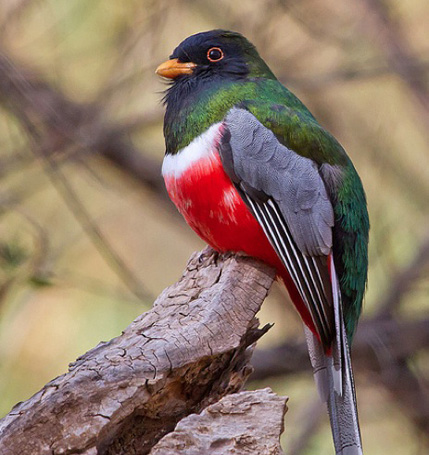
Planning a family road trip or researching a birding trip to another state?
A birding trail may be your best bet. Nearly 40 states have published at least one birding trail map, so you're likely to find one to suit your needs. Most maps contain multiple loops—and numerous stops—that were selected by the local bird experts to cover a variety of habitats and/or the avian specialties of the area. Read the stop descriptions to see which loops you’d like to visit, and start to plan your route. Most include notes about accessibility for the mobility impaired. Southern Florida, the Lower Rio Grande Valley in Texas, and Southeastern Arizona are birding “hotspots” and host well-traveled birding trail systems. The Great Washington State Birding Trail even has an app for iOS (Apple iPhone and iPod Touch). See a list of birding trails from the American Birding Association.
Birder/naturalist Jack Daynes has posted dozens of blogs -- Memories -- of some of the hottest birding spots in the country. Check them out!
Have a free day on your business trip or a spare morning on your family vacation?
If you want to find a nice area to go birding, look to see if the state has a birding trail map and, if so, find a stop or two near your location. From there, you can read the descriptions to see if the habitat or listed species interest you.
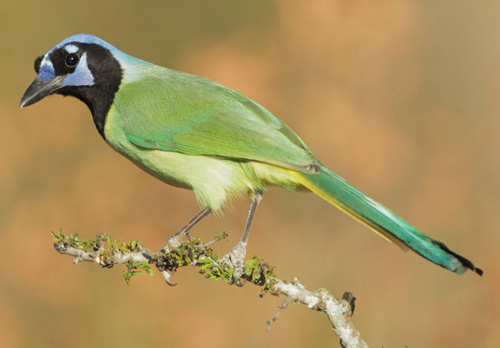
If you are looking for a special species, you can search Cornell’s eBird—a website where birders submit their sightings—by clicking on “Explore Data” and “Range and Point Maps” then typing the name of the species in the top left and name of the state (or county) in the top right. If you see only a bunch of squares, click on “Show points sooner”—blue markers show ALL records for the species, orange are in the last 30 days. You can play with the date range (e.g., to check just this year, or just this time of year) in the middle of the navigation bar at the top of the page.
If you don’t know the birds of the area, visit eBird to find yet another function that can help you stalk your quarry. Simply go to eBird, click on “Explore Data” then “Bar Charts.” Select the state you’re visiting and “Counties in …” (you may need to do a web search if you don’t know offhand) and hit “Continue.” Select the county and hit “Continue” to see a bar chart of sightings for the entire county. If you want to do a finer search and you believe it’ll be a popular area for birding (like a city park or national wildlife refuge), go back to “Bar charts” and select “Hotspots in …” and on the next page, scan for the name of the area. Once you click on the area (and there may be multiple “hotspots” within a location, depending on how big it is), hit “Continue”. The resulting bar chart should provide a nice summary of what species can be seen or heard, and when. Scan the list to find species that interest you, and click on the map to see specifically where they were reported in the area.
Just want to see what the local birdwatchers are talking about and seeing? You can also scan the email list archives for the local birdwatching communities on the American Birding Association’s website. Search under All Mailing Lists for the area of interest.
International business trip with a free day or two for birding?
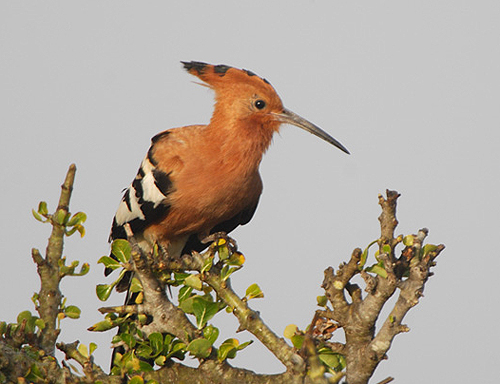
Check eBird, but be mindful the website is primarily populated by birders from the United States, thus international destinations don’t have as much coverage as domestic locations. (The U.K., however, hosts many native eBirders.) Quite a few eBird contributors have entered checklists from their international travels, but some functions, such as bar charts, may be a bit sparse.
You can also Google the name of your destination plus “birding” or “birdwatching” to see if any online resources exist. Fatbirder.com has aggregated online resources for a number of destinations.
Have only a free morning in a major city abroad?
Visit the The Urban Birder's website to see if there is a trip report from that location.
Have a bit more time to explore?
Download a trip itinerary and checklist from the Victor Emanuel Nature Tour website, by clicking here and select your desired destination on the right.
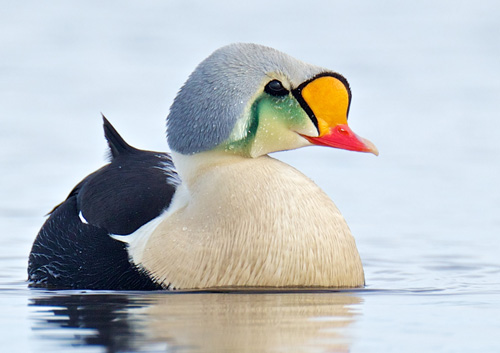
Sign up for a field trip or hire a guide.
No matter how much research you do, nothing can match the eyes and ears of a local expert. If you are traveling in the US, consider getting in touch with the local Audubon chapter to see if they have a scheduled field trip, and if non-members are able to attend. (Consider joining either way—membership fees are usually modest, and it's for a good cause!)
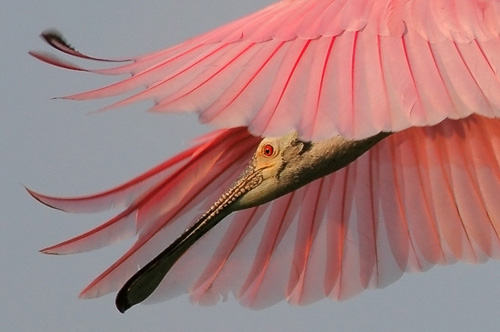
If there aren’t any field trips or local Audubon chapters, or it’s an international destination, search for professional birding guides or search BirdingPal’s website. You can search by region and scan the list of BirdingPals to see if anyone lives in or near your destination. BirdingPals vary by skill and availability (look at the last column), but they are all enthusiastic about showing “their birds” to out-of-town birdwatchers. Whether it’s paid or free, nothing compares to local expertise, and your checklist will benefit as a result.
One good thing about hiring a local guide, particularly in Central America, is that you're contributing to the well-being of that community or area and letting the people know that the birds and other wildlife there are of great value. Whether you travel to the next county or a far country, be sure to let the businesses you patronize know that you are there to see "their birds." (Learn more about ecotourism in this BirdNote show.)
For example, BirdNote producer Chris Peterson joined Road Scholar for their tour entitled "Birding the HotSpots of Costa Rica," which employs local guides and lecturers. "I had an exceptional guide, Roger Melendez, who, twenty years ago, had been trained in English with RARE. He really knew the birds, the places, and the people. It was an exhilarating and rewarding trip."

Roseate Spoonbill © Mike Hamilton
An easy way to find plenty of local experts, as well as a great place to go birding, is to attend a birding festival! No matter the month, state, or bird of interest, from the Kachemak Bay Shorebird Festival in Homer, Alaska, to the Birdiest Festival in America, in Corpus Christi, Texas, there's a festival for you. Start your search on the BirdWatcher's Digest website. When you go, be sure to wear your binoculars into local businesses — it underscores the economic importance of these festivals.
More of a do-it-yourselfer?
Use the eBird bar charts as a starting point, and use your field guide to study the species you’ll most likely see. If “birding by ear” is your thing, search the professional collection at The Macaulay Library, or download MP3s from Xeno-canto.org, and assemble a playlist. (Search for species and select the file name in the last column, then look for “Download audio file".) You can also download a smartphone app for the birds of North America from Sibley, National Audubon, National Geographic, or iBird. For Europe, check BirdGuides.
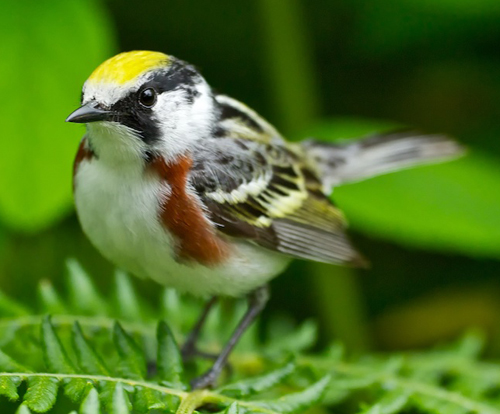
Are you looped in to your local birding community?
Wherever you are going, chances are other birders before you have visited your destination. If you belong to a birdwatching email list and the rules allow it, send a note to ask for recommendations on locations, guides, and local contacts.
Public lands offer great opportunities to see birds and other wildlife.
Find a national wildlife refuge or national park near you.
Your local Audubon chapter may offer field trips to public lands and other great birding spots.
And wherever you go, let the locals know why you're there. For the birds!
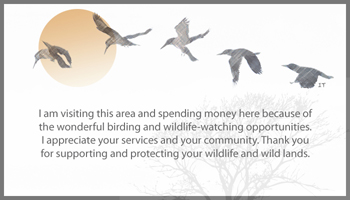
Carry this "birder's business card," and leave it wherever you shop or eat on your birding trips. It will let people in that community know that they have a precious resource and encourage them to protect it. (You can use this template to print out your own cards.)
Now, just don’t forget your binoculars!

